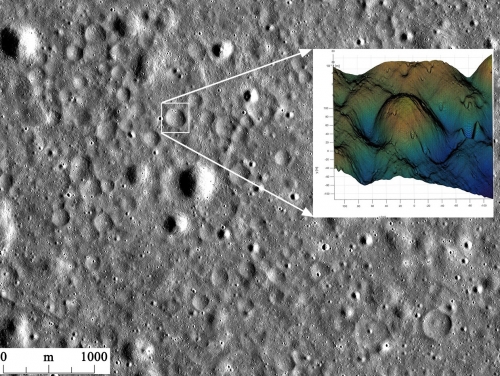A new type of volcanic geomorphologic feature on the lunar surface has been discovered, the findings were firstly published in Geophysical Research Letters, an international top geophysics journal, on September 13, 2017. The discovery was led by Macau University of Science and Technology, jointly with Brown University, U.S.A., Russian Academy of Sciences, Lancaster University, U.K., Peking University, and other institutions. This was another important scientific discovery by Space Science Institute of MUST in recent years in the lunar and planetary research discipline. The research findings have great scientific significances and provide insights for studying and understanding of lunar thermal evolution in the low-gravity lunar context, lunar volatiles and dynamics, and late-stage volcanic activities.
The research reports on a type of dome-shaped structures newly discovered on the dark volcanic plains on the moon; they are generally very low (a few meters to <20 meters high), encircled by ring-like depressions or moats; hence, named “Ring-moat dome structure” (RMDS). The RMDSs, whose diameters range from tens to several hundreds of meters, cluster or disperse randomly on the volcanic plains (large-size impact craters filled with lava), like vesicles or extruded blisters on human skins.
Although the Apollo lunar-probing program of the U.S.A. in the 1970s had six manned lunar landings, and the subsequent series of lunar-probing attempts by the international community has produced a large quantity of lunar images and data, the mysterious RMDSs, however, had remained undiscovered until this research, when the researchers were finally able to identify the structures from the high spatial resolution images that were taken when the sun was low above the horizon.
The researchers concluded that in the process of lava flow, a chilled crust was formed on the surface of the lavas, which played a role of heat insulation for the lavas underneath; the insulated lavas inflated because of the abundant volatiles contained; as the inflation amounts to a critical mass, the crust flexed and cracked, leading to eruption and forming magmatic squeeze-ups. As the number of the magmatic squeeze-ups increased, followed by late-stage evolution, the surrounding annular depressions are thus formed.
Researchers of the Space Science Institute have gained access to and methods of optimization of the Digital Terrain Model, which plays a critical role in analyzing the 3D structuring of such dome constructions (see the following figure). The researchers will continue to use high-quality observational statistics to conduct in-depth analysis of the subtle characteristics of such structures so as to deepen our understanding and further improve human knowledge on the lunar and planetary sciences.

RMDSs, domes on the moon encircled by ring-like moats; the embedded graph is a 3D structure of the domes.





